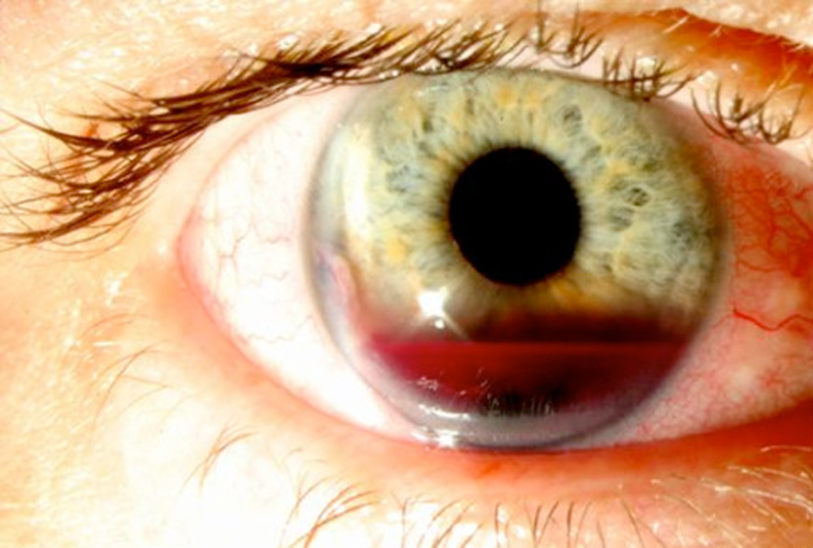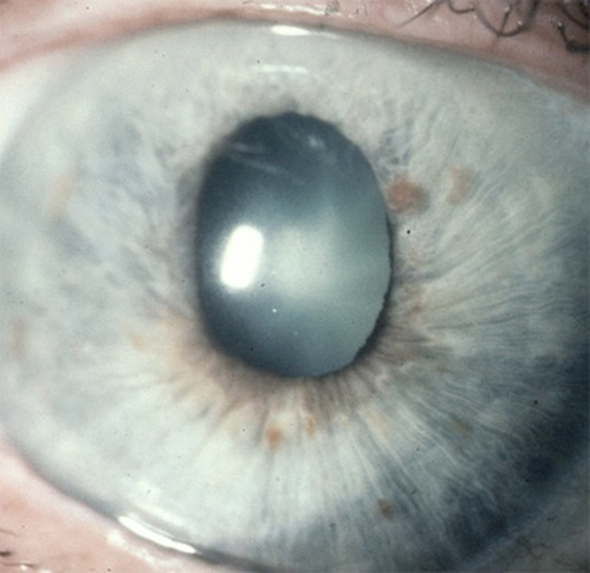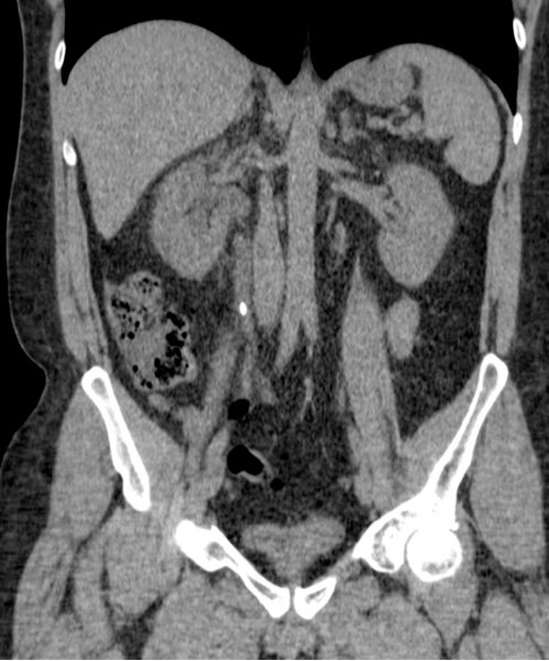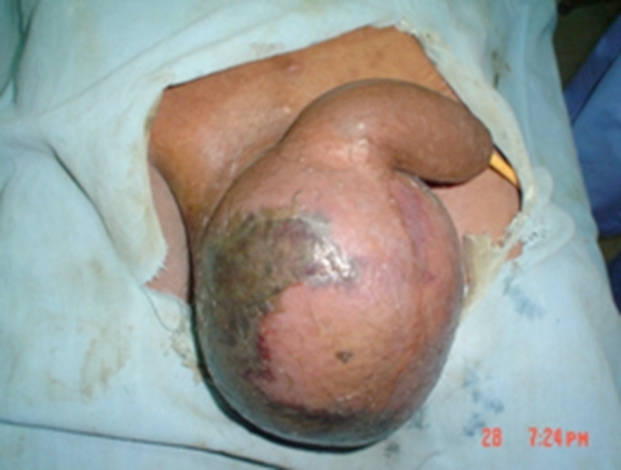MODULE three short answer questions.
saq 1.
An 18 year old man presents to the emergency department after being struck in the left eye by a squash ball. There was no associated loss of consciousness, and no symtpoms of acute head injury. A clinical image of the eye is showing below.
Question 1. What are the important findings in the image? (3 marks)
Must include: (1 mark each)
Question 2. What injuries are associated with this presentation (2 marks)
Must include
Question 3. What specific features relating to this presentation and the associated injuries will you examine for and why? (5 marks)
Must include: (1 mark each)
Must include: (1 mark each)
- hyphaema/blood in anterior chamber
- does not obscure pupil/grade 1
- regular pupil
- injected medial sclera
Question 2. What injuries are associated with this presentation (2 marks)
Must include
- blowout fracture of the orbit
- rupture of the globe
Question 3. What specific features relating to this presentation and the associated injuries will you examine for and why? (5 marks)
Must include: (1 mark each)
- visual acuity
- extra-ocular muscle movements for entrapment
- orbital rims for tenderness/step
- intra-ocular pressure
- fundoscopy for retinal injury
- fluorescein stain for abrasion
saq 2.
A 65 year old woman presents to your department with an acutely painful left eye. The pain is extreme, and associated with vomiting. She describes blurred vision on the left, and the sensation of seeing halos around objects. She has no medical history of note, but does admit to wearing contacts.
Question 1. Give a differential diagnosis for this situation (3 marks)
Must include (1mark each)
Question 2. A clinical image of the patient’s eye is shown below. What are the important positive and negative findings? (2 marks)
Question 1. Give a differential diagnosis for this situation (3 marks)
Must include (1mark each)
- angle closure glaucoma
- acute keratitis (contact lens induced)
- conjunctivitis
- corneal abrasion/ulcer
- acute iritis
- foreign body
- or other reasonable cause
Question 2. A clinical image of the patient’s eye is shown below. What are the important positive and negative findings? (2 marks)
Must include
Relevant positives: (0.5 marks each)
Question 3. What is the likely diagnosis? (1 mark)
Must include:
angle closure glaucoma
Question 4. What treatment will you administer to relieve this condition? (4 marks)
Must include
Acetazolamide in a reasonable regime: 500mg IV +/- 500mg orally
Topical therapy:
Relevant positives: (0.5 marks each)
- irregular, mid sized pupil
- hazy cornea
- no hypopyon
- no contact lense/other foreign body
Question 3. What is the likely diagnosis? (1 mark)
Must include:
angle closure glaucoma
Question 4. What treatment will you administer to relieve this condition? (4 marks)
Must include
Acetazolamide in a reasonable regime: 500mg IV +/- 500mg orally
Topical therapy:
- 0.5% timolol 1 drop
- 2% pilocarpine 1 drop
- 1% apraclonidine 1 drop
saq 3.
A 17 year old male presents with severe onset left testicular pain, of 4 hours duration. He has no history of the pain previously, and no urinary symptoms of note. He is severely distressed by the pain, and is currently vomiting.
His vital signs are:
Question 1. What is your differential diagnosis? (2 marks)
Must include: (1 mark)
Question 2. What features will you look for to on examination to confirm the likely diagnosis? (4 marks)
Must include:
Torsion:
Question 3. You are asked by the on-call surgical registrar to perform an ultrasound of the testicle, as she is caught in theatre with an expected delay of more than 2 hours. Is this acceptable? Why or why not? (3 marks)
Must include: (in some form thematically) 1 mark each
Question 4. Describe your next actions. (1 mark)
Must include (0.5 marks each)
His vital signs are:
- HR 110 /min
- BP 118/79 mmHg
- RR 22 /min
- Sats 98% RA
- T 37.2 oC
Question 1. What is your differential diagnosis? (2 marks)
Must include: (1 mark)
- torsion of the testicle
- epididymo-orchitis?STD
- torsion of appendix testis
- inguinal hernia
Question 2. What features will you look for to on examination to confirm the likely diagnosis? (4 marks)
Must include:
Torsion:
- excruciating pain to even light touch
- high riding left testicle
- transverse lie of testicle
- loss of cremasteric reflex
Question 3. You are asked by the on-call surgical registrar to perform an ultrasound of the testicle, as she is caught in theatre with an expected delay of more than 2 hours. Is this acceptable? Why or why not? (3 marks)
Must include: (in some form thematically) 1 mark each
- time critical emergency/already on edge of window for salvage
- definitive answer is gained by surgical exploration NOT ultrasound
- therefore a 2 hour delay is unnacceptable
Question 4. Describe your next actions. (1 mark)
Must include (0.5 marks each)
- escalation to consultant urologist/surgeon on call
- clear documentation of times and events
saq 4.
A 55 year old male presents with left sided flank pain radiating down into his right testicle. It is intermittent in nature and leaves him severely distressed. He has a history of renal colic, and states that this pain closely resembles his previous episodes.
Question 1. Discuss CT versus ultrasound this patient with regard to sensitivity, harm and overall diagnostic utility. (6 marks)
Must include: (1 mark each, theme dependent)
non contrast CT:
Ultrasound
Question 2. A CT KUB is performed and the image is below. What are the important positive and negative findings? (4 marks)
Question 1. Discuss CT versus ultrasound this patient with regard to sensitivity, harm and overall diagnostic utility. (6 marks)
Must include: (1 mark each, theme dependent)
non contrast CT:
- Sensitivity 90%
- Harm - ionizing radiation
- Diagnostic utility - good sensitivity, diagnoses other intra-abdominal conditions
Ultrasound
- Sensitivity ~60%
- Harm - minimal
- Diagnostic utility - shows important complications of stones (hydronephrosis), limited utility for other conditions except biliary ones
Question 2. A CT KUB is performed and the image is below. What are the important positive and negative findings? (4 marks)
Must include:
Positives (1 marks each)
Negatives (1 marks each)
Plus other comments from (0.5 marks each up to one mark)
Positives (1 marks each)
- stone right mid ureter
- proximal hydronephrosis/hydroureter
Negatives (1 marks each)
- normal calibre aorta
Plus other comments from (0.5 marks each up to one mark)
- early fat stranding around R kidney
- normal abdominal contents/no perforation/no bowel inflammation or other reasonable comment
saq 5.
An 83 year old man is brought in from a local nursing home with a fever and increasing confusion. He has multiple medical conditions, including Alzheimer’s dementia, type two diabetes, benign prostatic hyperplasia and ischaemic heart disease.
His vital signs are:
Question 1. A venous blood gas is taken on arrival. Interpret the results. (4 marks)
FiO2 21%
pH 7.09
pCO2 22 mmHg
pO2 66 mmHg
HCO3- 9 mmol/L
Na+ 140 mmol/L
K+ 4.5 mmol/L
Cl- 103 mmol/L
lactate 9.8 mmol/L
Must include: (1 mark each)
Critical RAGMA
Profound hyperlactataemia
Implies severe sepsis
Plus (0.5 marks each up to 1 mark)
compensatory respiratory alkalosis/appropriate respiratory compensation
formal calculation of anion gap = 28
delta ratio ~1.0
Question 2. A clinical photograph of your examination findings is included below. Describe the photograph and give a diagnosis. (2 marks)
His vital signs are:
- HR 140 /min
- BP 92/60 mmHg
- RR 31 /min
- O2 sats 99% RA
- T 39.6 oC
Question 1. A venous blood gas is taken on arrival. Interpret the results. (4 marks)
FiO2 21%
pH 7.09
pCO2 22 mmHg
pO2 66 mmHg
HCO3- 9 mmol/L
Na+ 140 mmol/L
K+ 4.5 mmol/L
Cl- 103 mmol/L
lactate 9.8 mmol/L
Must include: (1 mark each)
Critical RAGMA
Profound hyperlactataemia
Implies severe sepsis
Plus (0.5 marks each up to 1 mark)
compensatory respiratory alkalosis/appropriate respiratory compensation
formal calculation of anion gap = 28
delta ratio ~1.0
Question 2. A clinical photograph of your examination findings is included below. Describe the photograph and give a diagnosis. (2 marks)
Must include:
IDC in situ (0.5 marks)
Swollen discoloured scrotum (0.5 mark)
Implies a diagnosis of Fournier’s gangrene (1 mark)
Question 3. Outline your management (4 marks)
Must include (1 mark for each theme)
- discussion with family about gravity of prognosis and limits of care/palliation
- fluid resuscitation to reasonable endpoint (systolic BP >90 & HR 100, Cap refill <2s, Urine output >1 ml/kg.min, lactate clearance etc)
- administration of appropriate antibiotics if indicated by care planning: piptaz or ceftriaxone plus metronidazole
- referral to a surgeon for definitive opinion



